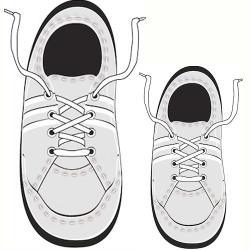Source Institutions
Source Institutions
Add to list Go to activity
Activity link broken? See if it's at the internet archive

In this math lesson, learners explore the concept of using units to measure length. Learners first read "How Big is a Foot" by Rolf Myller and learn about units. Then, learners visit four measurement centers. In each center, learners will measure items with various kinds of units. Learners use non-standard units to measure their shoes, the distance between beanbags and a bull’s-eye target, their body parts (arms, legs, etc.), and some everyday objects. This lesson guide includes instructions on how to set up a "Shoe Store" dramatic play area that can be used to introduce learners to measurement prior to this activity.
- 30 to 45 minutes
- 45 to 60 minutes
- $5 - $10 per group of students
- Ages 4 - 6
- Activity, Lesson/Lesson Plan
- English
Quick Guide
Materials List (per group of students)
- "How Big is a Foot" by Rolf Myller
- Brightly colored box
- Left shoe
- Right shoe
- Adult pair of scissors
- Child-sized pair of scissors
- Heel to Toe recording sheets
- Shoe
- Regular-sized paperclips
- Connecting cubes
- Wooden blocks
- Lima beans
- Toothpicks
- A bull's-eye target board
- 6 pairs of bean bags, each set a different color
- One of these nonstandard units of measurement: connecting cubes, jumbo paperclips, or straws cut identical lengths
- 6 crayon boxes
- 6 pieces of chalk
- 6 blocks
- 6 markers
- 12 beads
- Jumbo pipe cleaner
- Grab Bag Measurements
- Bag or sack
- Measuring Me! recording sheets
- Paper for four graphs with titles and pictures
Subjects
-
Life Sciences
- Human Body
-
Mathematics
-
Data Analysis and Probability
- Data Analysis
- Data Collection
- Data Representation
-
Measurement
- Units of Measurement
- Size and Scale
-
Data Analysis and Probability
Informal Categories
- Literature
- Toys
Audience
To use this activity, learners need to:
- see
- see color
- be mobile
- touch
Learning styles supported:
- Links STEM to other topics of interest such as arts and humanities
- Involves hands-on or lab activities
Other
Includes alignment to state and/or national standards:
Includes assesments for student learning:
This resource is part of:
Access Rights:
- Free access
By:
- Lyman, Nichol
Rights:
- All rights reserved, Utah Education Network in partnership with the Utah State Office of Education and Higher Ed Utah,
